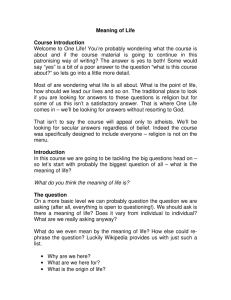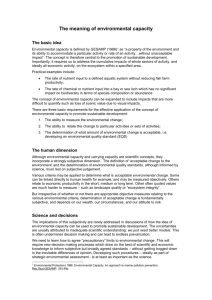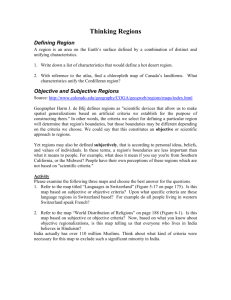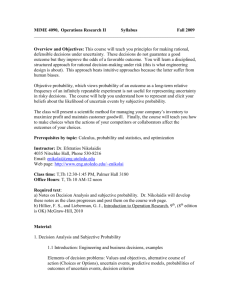Soap Note Quiz
advertisement
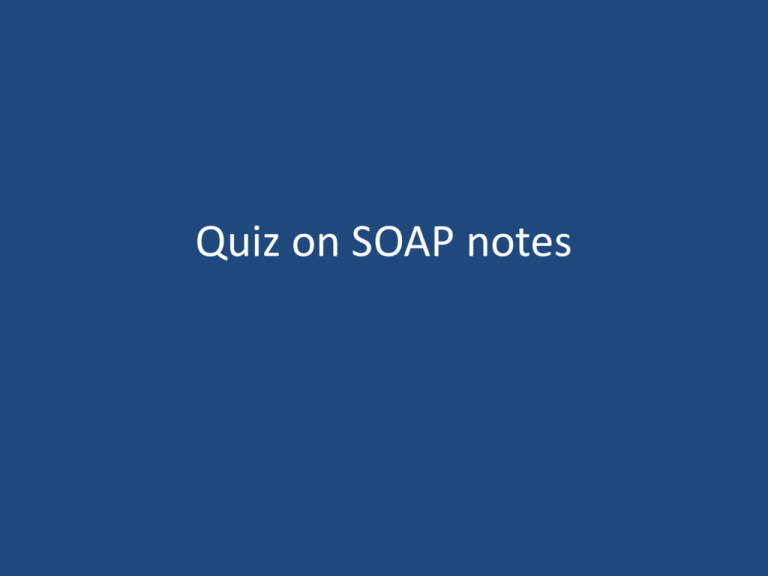
Quiz on SOAP notes Part One This part of the quiz will ask you to choose whether the data presented is subjective or objective information. These particular items are common problems for student NPs. Read the data, make a choice, then left click again to discover the right answer. Reminder: Subjective: what you can not verify by your own senses or hard data. Objective: what you can verify. Many data points are covered to get you used to thinking about the difference. When you have had enough, scroll down to Part Two for the multiple choice quiz on other parts of the SOAP note. If you have any questions about any part of this quiz consider bringing it up in a conference forum! 1) CBC result from last week • Subjective • Objective 2) B/P done by the office RN • Subjective • Objective 3) Urine dip done by office nurse • Subjective • Objective 4) Pain when walking on Rt ankle • Subjective • Objective 5) Limping • Subjective • Objective 6) Pain with passive ROM of ankle • Subjective • Objective 7) Dislikes vegetables • Subjective • Objective 8) Hyponasal speech • Subjective • Objective 9) Pain with deep breath • Subjective • Objective 10) Pain with coughing • Subjective • Objective 11) Pleural rub • Subjective • Objective 12) Irregular Pulse • Subjective • Objective 13) Palpitations • Subjective • Objective 14) Dysuria • Subjective • Objective 15) Muscle Pain (pt on Lipitor) • Subjective • Objective 16) Ecchymoses • Subjective • Objective 17) Periorbital Edema • Subjective • Objective 18) Cool periphery • Subjective • Objective 19) Rebound tenderness • Subjective • Objective 20) Joint stiffness when getting up in the morning • Subjective • Objective 21) Pitting edema • Subjective • Objective 22) Unemployed • Subjective • Objective 23) Poor hygeine • Subjective • Objective 24) Divorced • Subjective • Objective 25) Works with Asbestos • Subjective • Objective 26) Flu vaccine reported as given on patient’s chart • Subjective • Objective 27) Flu vaccine obtained at local flu clinic as reported by patient • Subjective • Objective 28) Snoring reported by wife • Subjective • Objective 29) Pruritis • Subjective • Objective 30) Shortness of breath when getting onto exam table • Subjective • Objective 31) Shortness of breath after walking one block • Subjective • Objective 32) Mother had breast cancer • Subjective • Objective 33) Eye discharge in inner canthus • Subjective • Objective 34) CVA tenderness • Subjective • Objective 35) Wakes several times every night • Subjective • Objective 36) Dizziness • Subjective • Objective 37) Positive Rhomberg • Subjective • Objective 38) Snoring documented on sleep study report • Subjective • Objective 39) Lives in a student dorm • Subjective • Objective 40) Eats 3 meals a day and 2 snacks • Subjective • Objective Part Two: Multiple choice quiz Read the question, decide on an answer, then Left Click to see the correct answer. 1) Follow up instructions should always include the following EXCEPT: 1. 2. 3. 4. Return to clinic (RTC) in one week RTC if not improving in the specified time RTC prn What to do if there is a turn for the worse 2) Assessment/Analysis could include the following EXCEPT: a. b. c. d. The chief symptom A wellness diagnosis A patient request for an antibiotic A reference to a red flag symptom 3) Assessment/Analysis could include (choose the best answer): a. A tentative diagnosis b. A statement of intent c. A general statement about the patient d. A summary of the subjective and objective data 4) A diagnostic statement a. b. c. d. should always be stated with certainty is never really definitive needs to include a differential list should include a patient-focused goal 5) The Plan should always include the following: a. b. c. d. Mention a referral A medication A treatment A follow-up plan 6) Considering the subjective and objective information helps the NP arrive at (choose the best answer) a. b. c. d. A diagnosis A differential diagnosis A follow up plan Diagnostic tests 7) Red flag signs or symptoms should be addressed either directly with a comment, or indirectly with assessment data in which section(s) of the SOAP note? a. b. c. d. The S and O The A and P The O, A, and P The S, O, A and P 8) Which of the following items belong in the Subjective section? a. b. c. d. The person appears unkempt The person’s breath smells fecal The person works as a plumber All of the above 9) A diagnostic statement includes (choose the best answer): a. A statement about what the NP thinks it is and what it is not b. A statement including leading differentials, if unsure c. The status of the patient e.g. Stable, worse, improving, acute, etc. d. All of the above 10) A SOAP note is a. A way of organizing your thoughts b. A way of documenting a patient encounter that is understood by most health professionals c. Provides a comprehensive picture of the patient encounter and reflects the practitioner’s thinking process d. All of the above 11) It is important to indicate all of the following in a SOAP note EXCEPT: a. To differentiate between an emergency and a routine visit b. That the patient has been contacted to remind them about their follow-up appointment c. Who is responsible to arrange diagnostic tests d. State the status of a condition e.g. hypertension – controlled. 12) Functional Health Patterns include: a. Reports of dysuria, headaches and nausea b. Reports of falls, insomnia, and sedentary lifestyle c. Current weight, height and LMP d. Reports of itchy skin, fever, chills and palpitations Functional Health Patterns are subjective information 13) The Review of Systems (ROS) is a) b) c) d) Objective information Subjective information Not part of a SOAP note The same as the physical exam 14) Allergies, immunizations and medications go in what section of the SOAP note? a. b. c. d. The S The O The A The P Generally this information is reported to you by the patient. If you have seen hives as a result of an antibiotic, this would be objective info. If you had given the immunization (or someone in your office gave it) that would also be objective. Medications as reported by the patient are subjective and different from thinking about what they are supposed to be on. Be careful not to equate subjective information as untrue information. If a patient reports an allergy then it is prudent to take that info as a fact. The End January 2012 Centre for Health Studies Nurse Practitioner Program




